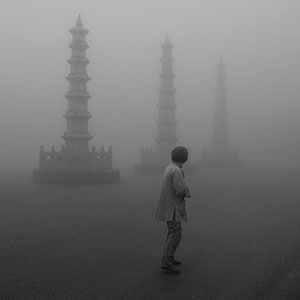

Hai Bo strips the human figure of its individuality in his solo exhibit “The Southern Series” (now at Pace Gallery) without destroying the narratives in these black and white photographs. Faces are turned away from or oblivious to the camera, darkened by shadows or otherwise obstructed from view. Bo assigns each work in the series a number rather than a name, a system that encourages an unregulated response from the viewer.
“No. 55” features three pillared shrines receding at a perpendicular angle to the grayed-out horizon line. In front of them, a woman stands in the foreground, just off center. She casts an Orphic gaze into the distance, finding nobody behind her in that dusky world.
Mirroring her stance is “No. 50.” Atop a hillside, a lone man stares at the setting sun. When paired, the two bodies stand back to back like Orpheus and Eurydice, permanently lost to each other. The atmosphere, the air they’re breathing in, looks like it’s been polluted. Both figures appear to be contaminated by a combination of factory smoke and grief.
“The Southern Series”, completed in 2015, is Bo’s response to “The Northern” (2012), a series of photos the artist took in Northern China. In his artist’s statement, Bo distinguishes between the two regions: “The north in China is material, and the south is spiritual.” He represents the spirit of these often unidentifiable southern regions as a monochromatic landscape veiled in fog, smog, rain, sleet or ash. Online and in print, the images look fuzzy or on the verge of blurring inside all of this miserable weather. In person, they’re clear and precise to begin with.
But instead of attaining maximum clarity by printing out a glossy end product, Bo develops or adjusts the pictures the way a painter does, in order to create the illusion of depth. The photographs look like they’ve been smoothed over with a varnish made of charcoal dust or pencil lead. He pays homage to an infinite number of grays, revering the complexity of its tonal range. That color’s subtletyor the way it absents colorisn’t appreciable in digital reproductions. The various shades are flattened down to a false monotone.
This is especially true in the case of large-scale images of urban buildings like “No. 12” (150 by 300 cm). The camera is up at roof level or higher, taking in the upper stories of nearby apartments and the multiple levels of others in the distance. Even though the frame itself is still, the photograph suggests the photographer’s eyes in motion, panning across this vista. Pigeons float above and descend upon one rooftop that’s closer to the viewer. What you can’t see in print or online reproductions that you can see in the gallery are water-stained walls that mark the buildings like scars or contusions. Bo teases out these imperfections with his lens in the same way that an etcher does in printmaking.
Amid this collection of dilapidation and ruin, human or otherwise, “No. 18” is a startling detour at the back of the gallery. Dressed in winter coats, a group of nearly two dozen people huddle together on a stone-paved street. An enormous wall stretches up behind them until it leaves the frame. The towering landmark is the city wall of Jingzhou. When he first visited there, Bo saw a few blind people telling fortunes under the city’s wall. Without this information to decode the image, you can infer from their rigid postures that these men and women are performing some kind of arcane ritual. Not a single face looks outside of the circle. Whatever that fortune teller has to say compels the audience to stand stock-still.
Although their faces are hidden, and their coats make them indistinguishable from one another, it’s the only photograph that displays human energies bristling with something besides detachment or lethargy. Commenting on his practice, Bo writes, “I like images that are between reality and fantasy. Pictures where people appear like occasional ghosts.” Most of us, while attuned to modernity, ignore those hazy dimensions where the spirit resides. Bo acknowledges the existence of a ghost world. He translates the sepulchral into visible rays of grayness and a modicum amount of light.
Hai Bo: The Southern Series
Thru Jul 15, Free
Pace Gallery
pacegallery.com


